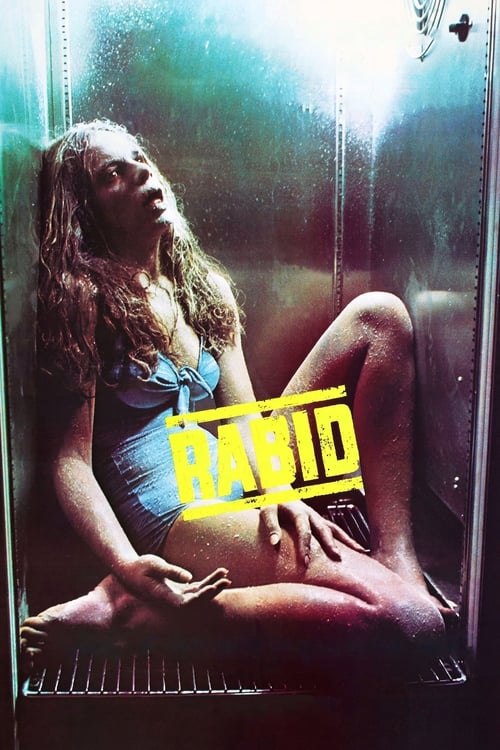Cast
View AllMarilyn Chambers
as Rose
Terri Hanauer
as Judy Glasberg
Frank Moore
as Hart Read
Joe Silver
as Murray Cypher
Howard Ryshpan
as Dr. Dan Keloid
Patricia Gage
as Dr. Roxanne Keloid
Susan Roman
as Mindy Kent
Roger Periard
as Lloyd Walsh
Lynne Deragon
as Nurse Louise
Victor Désy
as Claude LaPointe
Julie Anna
as Nurse Rita
Gary McKeehan
as Smooth Eddy
Terence G. Ross
as Farmer
Miguel Fernandes
as Man in Cinema
Robert O'Ree
as Police Sergeant
Crew
Director
- David Cronenberg
Writer
- David Cronenberg
Producer
- John Dunning
Reviews
John Chard
Hydrophobic Induced Phallic Destroyer.
Rabid is written and directed by David Cronenberg and it stars Marilyn Chambers, Frank Moore and Joe Silver. Cinematography is by Rene Verzier and music by Ivan Reitman.
When Rose (Chambers) is involved in a horror motorcycle accident, she undertakes experimental surgery in order to save her life. However, she develops a taste for blood and has grown a deadly orifice under her armpit. As the victims stack up and Rose grows ever more insane, the city is put on red alert.
David Cronenberg’s second full-length film continues the themes found in his smart debut Shivers from the previous year. Body horror and disease come to the fore but Cronenberg expands it out from the confines of one building, into a whole city! Once again operating with a small budget with great results, the director fills out the narrative with sweaty virus panic, intelligent barbs, addiction concerns and visceral nastiness, with the phallic destroyer under Rose’s arm a frighteningly bonkers creation. True to the director’s career peccadilloes, sex and violence also come under the microscope, while his camera work shows an inventiveness that off-sets the poor effects work. The city is suitably painted as dowdy so as to run concurrent with the diseased narrative, and porn star Chambers gives a very effective performance while others are merely adequate.
A simple story and periods of sag and drag stop it being top of the line Cronenberg, but there’s a raw energy to Rabid that is most striking. Watching it now as it heads towards being four decades old, it signals with intent a career being born of a most skilled auteur. 7/10
Oct 16, 2014
Thematic Analysis
This Horror/Science Fiction film explores themes of fear and survival, delving into the psychological aspects of human nature when confronted with the unknown. Rabid presents a unique perspective on the horror genre by focusing on the psychological terror rather than relying on typical jump scares.
Director David Cronenberg brings their distinctive visual style to this film, continuing their exploration of themes seen in their previous works while adding new elements. Their approach to pacing and visual storytelling creates a viewing experience that rewards close attention.
Released in 1977, the film exists within a cultural context that now offers viewers historical perspective on the social issues of that era. Its reception demonstrates the diverse reactions to its artistic choices and its place in cinema history.
Did You Know?
- The production of Rabid took approximately 31 months from pre-production to final cut.
- With a budget of $0.5 million, the film represented a significant investment in bringing this story to the screen.
- The final cut of the film runs for 91 minutes, though the director's initial assembly was reportedly 130 minutes long.
- The film contains approximately 2047 individual shots.
- The costume department created over 317 unique costume pieces for the production.
- The screenplay went through 8 major revisions before the final shooting script was approved.
Historical Context
- In 1977, when this film was released:
- The Watergate scandal changed public perception of political institutions.
- Disco music dominated popular culture.
- The film industry was dominated by major studios, with independent cinema still in its early development.
How This Film Stands Out
While Rabid shares thematic elements with other films in its genre, it distinguishes itself through its unique approach to storytelling, visual style, and character development.
Unlike Cube, which takes a more conventional approach to its subject matter, Rabid subverts genre expectations by exploring its themes with greater nuance.
While films like Cube Zero and The Hole explore similar territory, Rabid stands apart through its distinctive directorial vision and pacing.
This film's unique contribution to cinema lies in its thoughtful balance of entertainment value and thematic depth, making it a valuable addition to its genre.






























